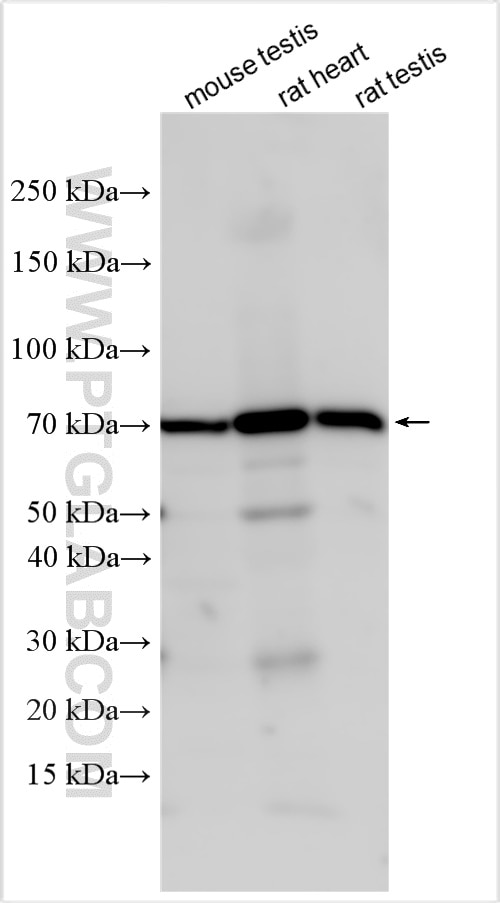SIAE Polyklonaler Antikörper
SIAE Polyklonal Antikörper für WB, ELISA
Wirt / Isotyp
Kaninchen / IgG
Getestete Reaktivität
human, Maus, Ratte
Anwendung
WB, ELISA
Konjugation
Unkonjugiert
Kat-Nr. : 14566-1-AP
Synonyme
Geprüfte Anwendungen
| Erfolgreiche Detektion in WB | Maushodengewebe, Rattenherzgewebe, Rattenhodengewebe |
Empfohlene Verdünnung
| Anwendung | Verdünnung |
|---|---|
| Western Blot (WB) | WB : 1:500-1:1000 |
| It is recommended that this reagent should be titrated in each testing system to obtain optimal results. | |
| Sample-dependent, check data in validation data gallery | |
Produktinformation
14566-1-AP bindet in WB, ELISA SIAE und zeigt Reaktivität mit human, Maus, Ratten
| Getestete Reaktivität | human, Maus, Ratte |
| Wirt / Isotyp | Kaninchen / IgG |
| Klonalität | Polyklonal |
| Typ | Antikörper |
| Immunogen | SIAE fusion protein Ag6143 |
| Vollständiger Name | sialic acid acetylesterase |
| Berechnetes Molekulargewicht | 58 kDa |
| Beobachtetes Molekulargewicht | 62-70 kDa |
| GenBank-Zugangsnummer | BC068450 |
| Gene symbol | SIAE |
| Gene ID (NCBI) | 54414 |
| Konjugation | Unkonjugiert |
| Form | Liquid |
| Reinigungsmethode | Antigen-Affinitätsreinigung |
| Lagerungspuffer | PBS with 0.02% sodium azide and 50% glycerol |
| Lagerungsbedingungen | Bei -20°C lagern. Nach dem Versand ein Jahr lang stabil Aliquotieren ist bei -20oC Lagerung nicht notwendig. 20ul Größen enthalten 0,1% BSA. |
Hintergrundinformationen
Sialic acids as terminal sugars of N- and O-glycosylated macromolecules are decisive for the functions of glycoconjugates both in soluble form and integrated into cell membranes .The two enzymes responsible for acetylation and de-acetylation have been described as sialate O-acetyltransferase (SOAT) and sialate O-acetylesterase (SIAE), respectively. SIAE deacetylates α(2-6)-linked sialic acid on N-linked glycans of BCR, allowing the interaction with CD22, that functions in vivo as an inhibitor of BCR signaling. (PMID: 26022516)
Protokolle
| PRODUKTSPEZIFISCHE PROTOKOLLE | |
|---|---|
| WB protocol for SIAE antibody 14566-1-AP | Protokoll herunterladen |
| STANDARD-PROTOKOLLE | |
|---|---|
| Klicken Sie hier, um unsere Standardprotokolle anzuzeigen |


